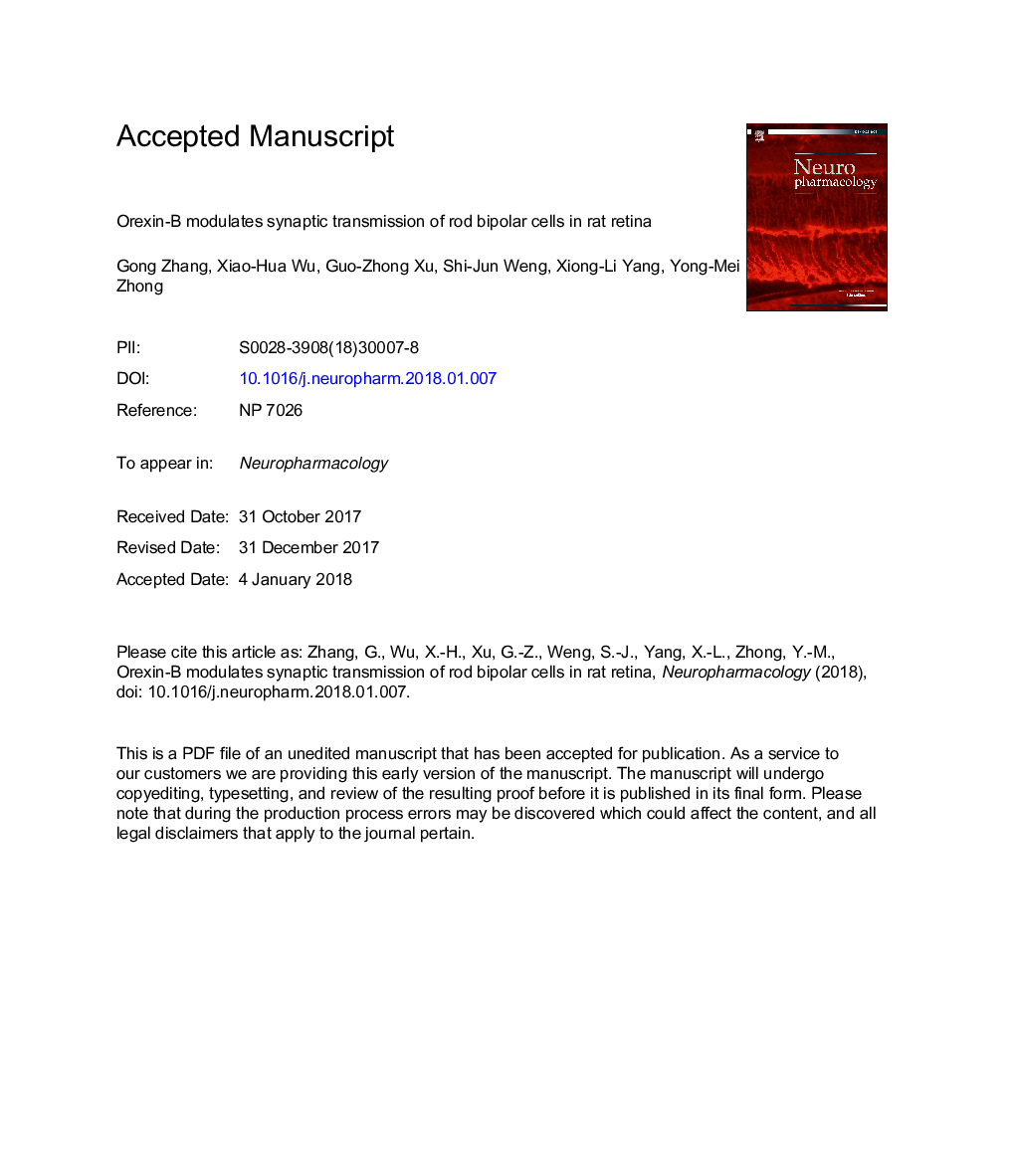| Article ID | Journal | Published Year | Pages | File Type |
|---|---|---|---|---|
| 8516958 | Neuropharmacology | 2018 | 55 Pages |
Abstract
Orexin-A, -B play a crucial role in arousal and feeding by activating two G-protein-coupled receptors: orexin receptor 1 (OX1R) and orexin receptor 2 (OX2R). Orexins, along with orexin receptors, are expressed in retinal neurons, and they have been shown to differentially modulate excitatory AMPA receptors of amacrine and ganglion cells in the inner retina. In this work we report that orexin-B modulates the activity of rod bipolar cells (RBCs) located in the outer retina of rat. Intravitreal injection of orexin-B increased the amplitude of the scotopic electroretinographic b-wave, a reflection of RBC activity, recorded in vivo. Patch clamp recordings in rat retinal slices showed that orexin-B did not change glutamatergic excitatory component of the RBC response driven by photoreceptors. Effects of orexin-B on GABA receptor-mediated synaptic transmission of RBCs were then examined. In retinal slice preparations orexin-B suppressed GABA receptor-mediated inhibitory postsynaptic currents of RBCs in the inner plexiform layer. Furthermore, using whole-cell recordings in isolated RBCs it was shown that orexin-B suppressed GABAC receptor-, but not GABAA receptor-, mediated currents of the RBCs, an effect that was blocked by OX1R and OX2R antagonists. The orexin-B-induced inhibition of GABAC currents was likely mediated by a Gi/o/PC-PLC/Ca2+-independent PKC signaling pathway, as such inhibition was absent when each step of the above-pathway was blocked with GDP-β-S/pertussis toxin (for Gi/o), D609 (for PLC), bisindolylmaleimide IV (for PKC)/rottlerin (for PKCδ), respectively. The orexin-B-induced potentiation of RBC activity may improve visual acuity and contrast sensitivity of the animal during the dark period (wake phase).
Keywords
VTAIPLPKCPTXSCNDT-PBSOPLPLCIPSCsBicucullinePKGDLGphorbol 12-myristate 13-acetateRBCsOX1RpKaPI-PLCOX2RERGTPMPAl-AP4PC-PLCBICCPPGPBSPhosphatidylinositol-specific phospholipase Cl-(+)-2-amino-4-phosphonobutyric acidPMAStrychnineOrexinphosphate bufferinhibitory postsynaptic currentsdiacylglycerolDAGBCsBipolar cellspertussis toxinPhosphate buffered salinephosphatidylinositolphosphatidylcholinePhosphatidylcholine-specific phospholipase Cphospholipase Couter plexiform layerinner plexiform layerventral tegmental areaNeuromodulationdorsal lateral geniculate nucleusSuprachiasmatic nucleiprotein kinase Aprotein kinase GProtein kinase CGABAARGABA receptorGABAA receptorGABAC receptorOrexin receptor 2orexin receptor 1
Related Topics
Life Sciences
Neuroscience
Behavioral Neuroscience
Authors
Gong Zhang, Xiao-Hua Wu, Guo-Zhong Xu, Shi-Jun Weng, Xiong-Li Yang, Yong-Mei Zhong,
